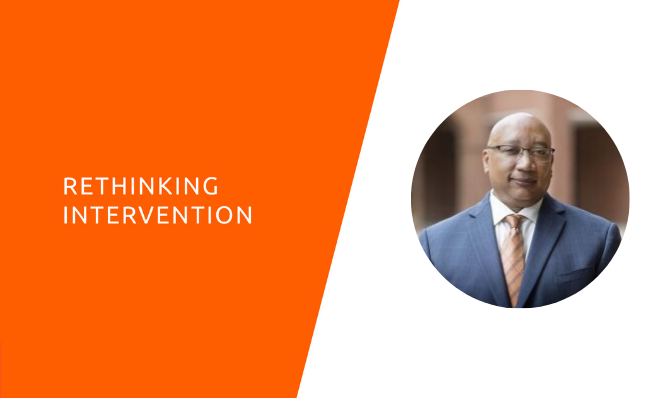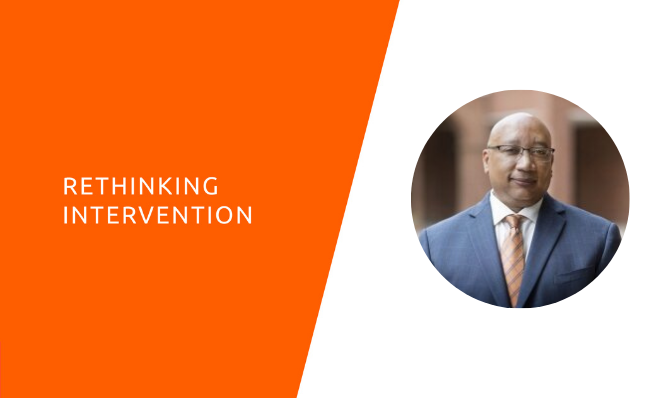
Robert Q. Berry, III, University of Virginia
Robert Q. Berry, III is the Samuel Braley Gray Professor of Mathematics Education at the University of Virginia and the Past President of the National Council of Teachers of Mathematics (NCTM). Equity issues in mathematics education are central to Dr. Berry’s research efforts within four related areas: (a) understanding Black children’s mathematics experiences (mathematical identities and agency); (b) measuring standards-based mathematics teaching practices; (c) unpacking equitable mathematics teaching and learning, and (d) exploring interactions between technology and mathematics education.
Dr. Berry spoke with Emily Freitag about the task of supporting the math learning needs of students in the wake of interrupted schooling.

EF: Can you share a bit about your personal learning journey and what that has taught you about learning?
RB: I grew up in Hampton, Virginia which is located in the Tidewater area of Virginia. When I was younger, I had the benefit of learning my multiplication tables quicker than other kids. When you think about a tracking system and elementary grades, that put me in the “high group.” But there were some insecurities. I was the kind of student who was in the middle. I didn’t cause any trouble and was pretty compliant. I would describe it as the kind of forgotten kid. Not going to cause any trouble, I’ll do my work and follow the rules.
In high school, I had an experience when I was taking analytical geometry, which kind of has some Algebra II and Trig. So it’s an interesting course because I don’t see that course listed hardly anywhere. I can remember the teacher’s name because they had a significant impact on me. Her name was Mrs. Warden. And it was her first year teaching. So that was interesting in and of itself. I can’t remember all the circumstances, but I didn’t do all my work in that class. In fact, I got to a point where I essentially gave up. Towards the end of the year, Mrs. Warden approached me and she said that she thought I could do better, and we actually made a deal. She said if I got an A on every quiz and test the last nine weeks of school, I could get an A in the class. I ended up doing it. So that was an interesting motivator. I ended up doing well in that class. As I reflect on that, I don’t know why I wasn’t motivated up to that point. Maybe I was bored with school, but I wasn’t motivated. It was those kinds of people along my trajectory who provided inspiration as I moved to undergraduate and on to graduate school. There were key people along my journey who were quite influential and then provided supportive relationships. And that’s a part of my own kind of work.
I say we teach more than math, we teach people. Sometimes as math educators, we focus on the content area, but not the human aspects of our work. I’m not trying to overgeneralize, but I do think that we teach people, and in doing that we have to forge the relationships necessary so that people/students are willing to take a risk. When I say take a risk, I mean how to create the social and emotional spaces in our classroom so students will be willing to take the kinds of risks that we hoped they would take. Sharing their problem-solving strategy, sharing their thinking, being verbal for many students is a risk-taking event. We have to develop an appreciation for when students put themselves out there. We need to think about how we support and nurture them so that they are willing to continue to take those risks along the way. Relationships are big for me and even though undergrad and my master’s degree, I had relationships with faculty members. My advisor was my biggest supporter. She saw things in me that I didn’t see myself as a teacher. When I worked on my master’s degree, I was teaching at the same time and she really encouraged me to move on to do a doctorate. My initial reason for getting a master’s degree was it puts me on a different pay scale so I can make more money. But what happened is that my master’s thesis won an award and got some recognition. My advisor really encouraged me to move forward and she introduced me to Carol Malloy who became my advisor when I did my doctorate at the University of North Carolina. I can’t say enough about Dr. Malloy and the kind of support she provided not only for myself, but her impact on math education as a field. There are several Carol Malloy students out there in the field, doing phenomenal work. I think there’s this kind of collective feeling that many of us have about her. When I was at Carolina, Dr. Molloy was on the board of NCTM. I had always been an NCTM member, becoming a volunteer, and working with the leadership structure and things of that nature. The year I got elected to the NCTM Board of Directors, Mark Ellis got elected, and Mark and I shared that we both went to Carolina. We both were Carol’s students. Dr. Malloy was so pleased that she had two other students on the board of directors of NCTM.
EF: Take us into your research and your leadership experience. We are exploring the question in this series about what we know works in the job of supporting and maybe even accelerating student learning that we can anchor in as students with exacerbated inequities and unfinished learning return to school.
RB: There are a couple of things as I think about the work that I’m doing now and the work I did when I was a classroom teacher. I taught in Newport News, Virginia for a number of years. I had a unique experience teaching a group of kids for three consecutive years. I looped with them and as a researcher looking back on that now, understand what affordances that I had in that experience. Several things happened. I didn’t have to develop relationships outside of this group of kids. When I taught fifth grade I taught math and science. In sixth and seventh grade it was just math. The relationships that developed with the students, and more importantly the relationship I developed with their parents, was significant. The school I taught at was located in downtown Newport News and has a high-risk population. It is in proximity to public housing. It is those relationships that I developed with those students, and a way of interacting with each other that formed a kinship. At the University of North Carolina, my dissertation focused on the voices of black boys who have been successful with school mathematics. At the time I focused on black boys who were in Algebra I or Geometry in middle school. It was a qualitative study. I was trying to figure out and understand their experiences. I’ll tell one story—one of the kids in the story takes sixth-grade math, and he wasn’t performing at the level which he was typically performing at. All through elementary school, he made A’s and B’s. During the transition from elementary to middle school, he just was not performing where he typically performed. It was recommended that he be switched from his advanced math course and moved down to a lower course. It wasn’t that he was failing sixth-grade math. He was making C’s and just not doing what he had typically done in the past. But this recommendation was focussed on not providing him additional support so that he can be as successful as he once was. The focus was on removing him. What impact would that have had on him moving forward? I tell that story because the story occurred before he was a participant in my study. But it resonated with the parents in such a way that speculated all the things that could have happened such as how his trajectory would have been different. I bring that story up because as I began to interview and talk with more of the boys, five of the eight participants had similar types of stories. The other common thing that these boys had, that I shared with them as well, is that sometime in third or fourth grade, they realized they were smart at math when they thought they knew their multiplication tables before all the other kids did.
EF: What is it about those multiplication facts? I mean, they are so emotional.
RB: They are and I think as a field we give those facts high status for some reason, they serve as a filter to determine whether the kids can or cannot do mathematics when we know that is not necessarily true. I’m not implying that we don’t want kids to know fluency, what I am implying is the kind of the time automaticity that was my experience. Although I was successful at it, and these boys were successful at it, it gave them kind of this entry point. But what about the other kids who were not successful at it, but could have just done the math and could have done really well?
EF: It is so interesting. It becomes an identity that becomes a self-fulfilling prophecy. Right?
RB: It certainly does. I wonder how that moment in third or fourth grade, what impact does that have on the student’s mathematical identity going forward? And how do we disrupt that? Because I think that knowing your multiplication tables with some level of automaticity so young can be problematic and I experience that as a parent as wrong. My youngest son, he didn’t know them fast like a timetable. My wife’s a math teacher and I do what I do, but what he did know is how to decompose numbers and figure it out. So when he had to do the mad minute, he just didn’t perform well. But if you asked him what seven times seven is, he’d probably decompose it to 7 times 5 and 7 times 2 because he knew he knew it was a 5 and 2 factor.
EF: That probably actually served him better when he got to algebra. Right?
RB: Exactly. So the time part is given so much status, which is problematic in many ways. We have to figure out how to disrupt that because we want thinkers, we want doers, and how do we construct that?
EF: I’m hearing a good “what not to do lesson” in this. What we know doesn’t work is labeling students based on one aspect of what they know or don’t know or can do or can’t do in a way that really harms their identity. What do we know works? As teachers prepare for the idea of students coming in with significantly increased unfinished learning, What can we lean on that we do know?
RB: I think there are a couple of things we can lean on. One of the things we can do is create spaces and opportunities for students to discuss their ways of knowing and thinking about mathematics. Once we know what they know, how do we then provide support? I’m hesitant to use the term “ intervention.” But, I do want to say the kinds of support for that, because what they know is what they know.
EF: Can I take you back for one second to ask why you’re hesitant about the word intervention?
RB: Because sometimes, intervention is very broad. When I think of intervening, I’m doing it for a purpose that might fit my needs or the curriculum needs. Maybe sometimes it’s not necessarily for the students’ needs. And not to imply intervention in a deficit way, but just kind of saying, first of all, what are the supports? If the goal is for a student to meet a benchmark and they don’t meet it, then we can do some type of intervention. I don’t want the framing to be positioned as intervene upfront without knowing what kind of resources students bring to the experience. Knowing and understanding those resources is significant. Too often, what happens is that we focus on what they don’t know. I want to focus on what they do know, and how we support them to move forward and create the space for them to have the efficacy and the motivation to continue their learning. So what is it that you want to know more about? That’s kind of the question that one might pose. What mathematics do you think you need to know? They may not have the vocabulary to describe the math they need to know. They can name that they need to be able to do X, Y, Z, or something like that though. Then as a professional, I can begin to have conversations and questions about that to begin to understand how we can create a structure with them that might be motivating for them to understand. So, I want to make the distinction between “intervention” and “support” as I’m using it, in this case.
EF: Thank you for that clarification, because it’s a word that’s actually very loaded. I was grateful to hear more. So what do we know works? You were saying creating space for mathematical conversations.
RB: I think discourse is important. How do we create more space for students to engage in discourse? Discourse can be not only verbal, but it also can be other kinds of representation where students communicate in mathematical ideas. So it can be pictures, it can be drawings, it can be demonstrations using manipulatives and tools. One might call those representations. I’m going to argue that discourse is a form of representation, but it’s a distinct form of representation. All of those other things that fit under-representation can also be a form of discourse. As a professional seeing students performing using a manipulative or tool, I want to then figure out how they’re making sense of it, then tag the verbal part to the performative part.
I think this idea of competence in authority comes into play here as well. How do we position students as being confident? We create space for them to demonstrate their understanding. That demonstration can be about questioning, all kinds of modes of discourse, it can be instructional routines. One of the instructional routines I like is “notice and wonder,” which is very popular. What “notice and wonder” does is add to the perception of taking a risk that all kids can notice. “So what do you notice about this? Oh, there’s a six oh, okay, I wonder what the six means?” All kids can notice, all kids can wonder, and when we do that we have an entry point to how they’re thinking, what is it that they see, what they are attuned to, and what they’re not attuned to. That is valuable information for me as a teacher to figure out rather than have them perform a task and either you’re right or wrong. I don’t have any more information to determine how you understood or even how you interpret the task. Your interpretation of the task might be different from my intention of the task. I mentioned authority earlier. I find too often that students do not have the maximum opportunity to author their own ideas. An example I’ve seen of this where I actually saw a pre-K teacher do this with a task that they were working on. I would characterize the tasks as a word problem task. She basically said, “I don’t really like this. I wonder what can we change about this story? Now I want some numbers in the story.” She moved the students towards mathematizing. Students author ideas, they mathematize the ideas. Now they engage in mathematics. There’s sort of this collected buy-in on these ideas. That’s one example, but just offering ideas, which then connect highly to discourse, right?
EF: I have a follow-up question on that. I find myself thinking about pedagogical content knowledge and just how much it requires. Can you tell us a little bit about what you have learned about how to equip teachers with the pedagogical content knowledge that allows them the comfort in facilitating this approach to instruction?
RB: I often say I wish I could go back and do some things again when I was a classroom teacher because I’m so much better now. I don’t want to imply that my younger self wasn’t effective. I think one of the things with pedagogical content knowledge is there are a couple of things at play. Knowledge of students, knowledge of curriculum, and all those things are at play. The other thing that comes with that reminds me of Peg Smith’s work around the five practices and anticipating student’s thinking. When you think about productive discourse, I think some of the advantages that a more experienced teacher may have over a novice teacher is that as a student is engaging in a task, you can in the planning of the tasks anticipate some level of the range of ideas that may come forward. The thing that ties it to pedagogical content knowledge is what is the follow-up? How do I impact or think about a student’s representation around those ideas? It’s understanding students’ thinking about mathematics. To me, that’s a high metacognitive load that teachers carry. All the decisions that teachers make at the moment and then throughout the lesson can be very hard to track. Even some of the decisions are not visible, sometimes those decisions are instinctive based on experience. This is where sometimes we have to disrupt that for teachers in terms of thinking about instinct and really thinking about the curriculum and how they intersect with kids’ thinking and being intentional and purposeful. Oftentimes, when I’m working with pre-service or novice teachers, rather than trying to give them all of these things to work on, one of the first things I try to do is slow down. I want them to slow down their processing because they can then be more intentional about how they’re going to think about the work that they’re doing with their students and in planning the mathematics they want to learn and teach and that they want students to learn. When I say slow down, my intent is to get them to really think deeper and be more intentional in this place, because I do think there’s a level of anxiety wanting to do content coverage. “I got all this stuff I have to teach.” Right? I get the pressures of high stakes testing. I get all of that. What is a way to think about how content is connected, and how you can get some depth and then figure out then how that affords you an increased opportunity that you still can cover the content? It is the depth of the content that students will know and understand.
EF: I think about that so much right now, because it does feel like everyone is kind of a first-year teacher again, in the distance context. We’re all back in that space. That idea of, How do we slow down and be intentional about the most important work? I think that’s more relevant than ever.
RB: Even as we move forward to the future, I think we’re going to have to really think about: What are the big ideas? The other thing is, if we are doing this in a remote space, it’s different teaching. It’s totally disruptive to your pedagogy. It is a different modality of teaching. To try to replicate face-to-face in a Zoom setting or online may not afford you the opportunities that you hope would happen in working with your students. It requires thinking very differently. Use the things that you are comfortable with, but the use of technology is going to push you and your students to think about mathematics in very deep ways and not cover a lot of stuff.
EF: We are hearing some debate about the idea of remediation. In particular, “do I meet kids where they are? Or do I start with my grade-level content?” Any perspective you have, from your experience in research on that question?
RB: NCTM has worked with NCSM, the National Council of Supervisors of Mathematics, and we’ve had discussions along those lines. One of the things that we’ve discussed is that students have to learn grade-level mathematics. As we move into the future, we also have to figure out what are the big ideas that may have not yet been learned? Then. how do those ideas connect to the grade-level mathematics that they’re going to be learning? So, if I’m a fifth grader, and there might be some unfinished work that I didn’t cover in the fourth grade—how does that connect to the fifth-grade curriculum? I’m still doing fifth-grade curriculum, but this is where support for teachers comes into play. I would not be supportive of “Let’s just teach the last nine weeks of fourth grade, and then start with grading a new year.” I think we have to be intentional about thinking about what those things are, and it’s going to be hard to cover all those things. We have to elevate the big ideas that students need to know and understand and how they connect with big ideas to the things that they’re going to learn in fifth grade (if I’m using this two grade-level example). I would not advise starting the school year off with large scale testing. I think we have to be purposeful with formative assessment. This is where I think some additional supports might have to come into play for teachers. What are some effective formative assessment techniques and strategies that we can use to support students’ thinking?
EF: Which really comes right back to notice and wonder and represents understanding different representations of math.
RB: When we do large scale assessments or high stakes testing, or some type of large scale assessment at the beginning of the year, we lose instruction. We lose even more instructional time. If we take a position on formative assessment, we can maximize instruction opportunities. We can also respect teachers as professionals to know and understand what students need to know, where the unfinished learning was, and then try to connect that. I want to position respecting teachers as professionals to use formative assessment strategies, and then connecting those unfinished things to the thing that they have to learn on grade-level, to not create more unfinished learning by just continuing.
EF: Thank you for joining our Rethinking Intervention series and I look forward to watching what NCTM produces. We’ve been so grateful for the 100 Days of Learning that you all have provided this year and are excited to continue to learn together.


